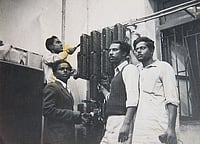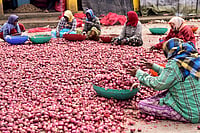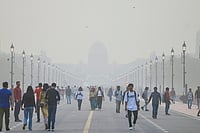When someone says museums, they bring to mind stone and stiffness, kings and queens and slaves. But what about the everyday humans of history? People like you and me and our myriad traditions, customs, rituals, habits? Where do they go? Do they die along with the body? And what about the body itself that carries with it its own memories and history? These are the questions that we at Outlook are trying to answer through our collaboration with Bihar Museum Biennale.
Exploring Museums, Memories And Inclusion At Bihar Museum Biennale Event In Delhi
The second in a series of discussions leading up to the Bihar Museum Biennale, was held at Bikaner House in New Delhi on Saturday. The event witnessed the presence of prominent personalities from the Indian art world and the world of architecture, museums and academia.

The second in a series of discussions leading up to the Bihar Museum Biennale, was held at Bikaner House in New Delhi on Saturday. The event witnessed the presence of prominent personalities from the Indian art world and the world of architecture, museums and academia including artists Subodh Gupta, Vibha Galhotra, academician Apoorvanand and Arindam Banerjee among others.
Through a series of panel discussions with the who’s who of the art world, Outlook tried to look at history not as a static, linear story but a fluid tapestry made of not just the ‘bests’ and ‘worsts’ but the ordinaries and the everyday – the lived memories and experiences of people.
Democratic and accessible museums ?
At the first panel discussion, Bihar Museum Director General Anjani Kumar Singh joined artist Dayanita Singh and Outlook Editor Chinki Sinha to explore how museums can become more accessible and democratic. Not just in terms of accessibility for audiences but also inclusion of all sections of population, including the tribals and diaspora.
Anjani Kumar Singh shed light on the profound motivations behind the conception of the museum. “To showcase the history of Bihar and to create a museum of international standards that reflected the contemporary history of Bihar and India,” he said.
Echoing the idea of creating an inclusive space to discuss art and museums, he said, "Museums have to be inviting, they are activities, how communities are engaging with them. There has to be democratisation of museums, where people can touch it.?
He further highlighted how museums have to provide hands-on experiences, especially to children. "It’s important for museums to provide 'touch and feel’ experiences. We have to have faith in people, children (that they will not spoil the artefacts)," he said.
Here lies the alternative concept where the public gets attached to the museum.
Explaining what museums of the future would or could be like, Dayanita Singh said, "Museums of the future are small and portable - a suitcase museum on wheels."?
Speaking on objects’ functionality and collective memory, Dayanita Singh said, "I once thought museums create Collective memory but in reality, they just become storage. Collective memory is created not in museums but in the home or one's village or bedroom. So when we are able to take a museum home with us, it too becomes part of collective memory. That is a truly living museum, an archive that is alive in your house, that you can see and touch."
Museums and conflict?
Avni Sethi of Conflictorium, YS Alone, art historian and JNU professor, Gustav Imam, the curator and collector of Sanskriti Museum, and Professor Ajay Gudavarthy joined Editor Chinki Sinha for a discussion on museums and conflict.
The Conflictorium in Ahmedabad acts as a space that enables different sections of the society to engage in various topics of conflict through artistic and creative ways. It was born out of the violence Ahmedabad witnessed.
On these lines, Avni Sethi said, “We live in a complex society, we don't have the space to talk about the complicated society. While Ahmedabad had seen excruciating violence and how it shaped the city, its architecture and its culture... The people had either been perpetrators, victims or witnesses. If you are any of this, your life can be changed. The Conflict Museum came out of it. We live in the age of narratives. There would be two ways to change the narrative, either through text books or museums."?
Professor YS Alone asked some important questions. He said that in artistic things, we do have transcendental meaning without addressing the people who need to have some connections.?
He asked: where is the representation? Why can't we have a museum of consciousness? China has a museum of poets. Can't we have one? Marathi literature is full of Dalit poetry that challenges the brahminical narratives. Why can't we have these kinds of museums?
Gustav Imam, the curator and collector of the Sanskriti Museum, said that the museum started in 1991. "Bihar and Jharkhand are not much different. Jharkhand has coal. There was mass displacement of people in Jharkhand. My father’s work was in an area where tribal people were being displaced. There was no rehabilitation programme then. I have witnessed these things as a young boy. My father also discovered tribal art. He had an idea he could use this art and museum to take the message to the people," he said.
While talking about the significance of museums, Professor Ajay Gudavarthy focused on how in India, most things are living and hardly anything can be ‘museumised’. Referring to untouchability, he asked if it would be placed in a museum? “Do we have any possibility?” – he asked.
With these discussions and collaboration with the Bihar Museum, Outlook tried to preserve memory as a museum and place everyday objects outside of their everyday settings to establish their true place in India’s cultural history.?
The insightful evening ended with a melodious performance by Chandan Tiwari, a folk singer from Bihar who sings in Bhojpuri, Maithili, Awadhi, and Nagpupuri among other languages from the state.
- Previous Story
 Artistic Legacy: Bihar Museum Showcases A Vibrant Display Of Traditional Folk Art Forms
Artistic Legacy: Bihar Museum Showcases A Vibrant Display Of Traditional Folk Art Forms - Next Story




















